Common menu bar links
Institutional links
Diseases & Conditions
Health & Safety
Research & Statistics
Agency Information
Search Box
Healthy settings for young people in Canada
Previous | Table of Contents | Next
Opposite-Sex Friends

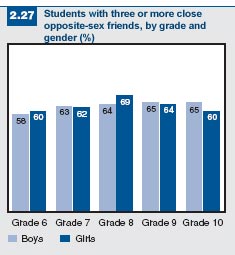 It is interesting that the proportion of
students with three or more close oppositesex
friends remains relatively stable after
Grade 7 for boys, but peaks at 69% in
Grade 8 for girls with a gradual decline to
60% in Grade 10. It is clear that young
people, even those in Grade 10, are more
comfortable having friends of the same sex
(see Figure 2.23) than of the opposite sex
(Figure 2.27). This could be due to their
socialization which may characterize
relationships with the opposite sex as
being associated with physical attraction
and romantic involvement rather than
friendship.
It is interesting that the proportion of
students with three or more close oppositesex
friends remains relatively stable after
Grade 7 for boys, but peaks at 69% in
Grade 8 for girls with a gradual decline to
60% in Grade 10. It is clear that young
people, even those in Grade 10, are more
comfortable having friends of the same sex
(see Figure 2.23) than of the opposite sex
(Figure 2.27). This could be due to their
socialization which may characterize
relationships with the opposite sex as
being associated with physical attraction
and romantic involvement rather than
friendship.
On the other hand, young people generally become more comfortable talking to their opposite-sex friends in Grade 10 (Figure 2.28), when around 70% of girls and boys report talking about things that really bother them to friends of the opposite sex. This pattern has remained fairly consistent over the five survey years (Figures 2.29 and 2.30).
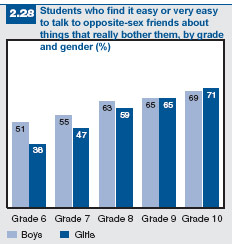
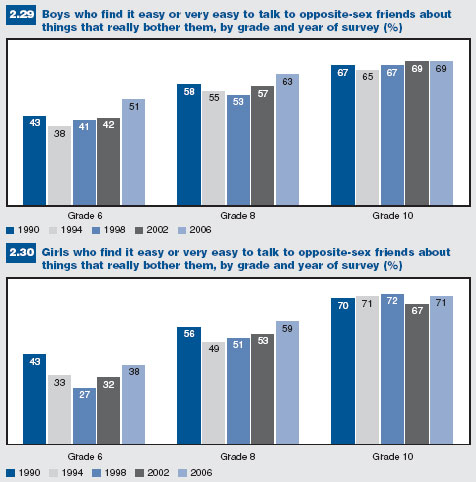

Best friends
Confiding in one’s best friend regarding things that are bothersome is very common for school-aged young people, particularly for girls across the five grades (Figure 2.31). This finding is not surprising, since a oneto- one relationship with a best friend is generally more intimate, involving more self-disclosure, than friendships that are within a peer group.
Interactions with friends
The proportion of students who spend four to five days a week with friends right after school drops significantly between Grades 8 and 10, for both boys and girls (Figure 2.32). However, only a fifth of girls in Grade 10 spend time with friends right after school, compared to a third of boys.
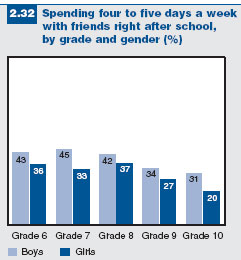
A downward trend is noticeable for students in Grade 10 over the past five survey years (Figures 2.33 and 2.34). For example, 31% of Grade 10 boys and 20% of Grade 10 girls report spending four to five days a week with friends right after school in 2006, compared to 48% and 32% in 1994.
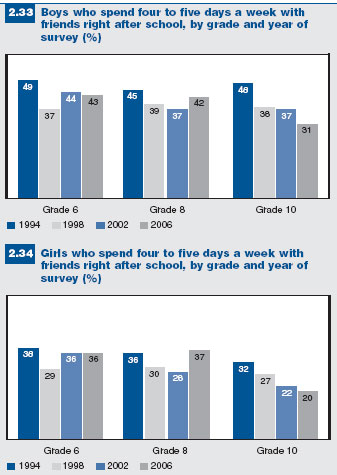
There is a similar decline in evenings spent out with friends for both boys and girls (Figures 2.35 and 2.36). In 2006, 21% of Grade 10 boys and 14% of Grade 10 girls report spending five or more evenings a week out with friends, compared to 27% of boys and 22% of girls in 1994. Several reasons for this decline are possible, such as: increased academic demands caused by revised curricula and competitive requirements for postsecondary education; financial demands requiring that students seek part-time employment after school and on weekends; and cyber communication that replaces direct face-to-face contact among young people (see Figure 2.37).
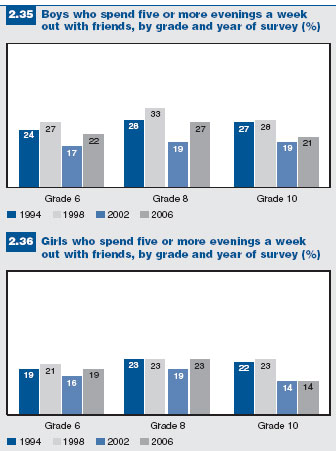
Figure 2.37 illustrates the popularity of phoning friends or sending them text or email messages. There is a consistent increase in these interactions across the grades for both boys and girls, although significantly more girls than boys are involved.

